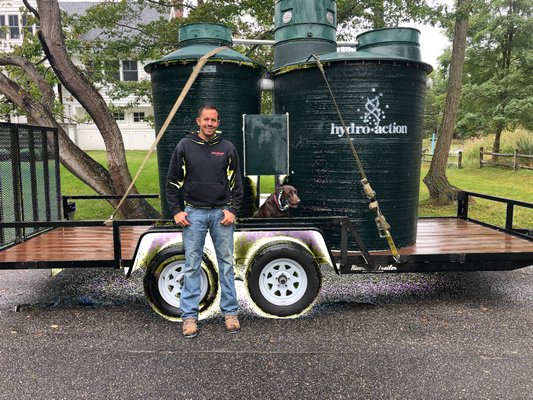
Taking the science that shows old septic systems and cesspools are a major player in nitrogen pollution and a detriment to Long Island’s water quality, Suffolk County has imposed a cesspool ban that requires homeowners to replace cesspools with a septic system rather than another cesspool. The law, which went into effect this past summer, was created to limit the amount of nitrogen entering local bays, waterways and harbors. Passionate about cleaning up the water and educating consumers on the value of advanced wastewater treatment systems, John Parry of South Fork Septic has found this move by the county, installation grants for state-of-the-art systems and the technology of these systems can make one of the most significant impacts in preserving and protecting ground and surface waters.
With the end result being cleaner water, Parry would like to see all homeowners move to innovative and alternative onsite wastewater treatment systems. These systems, however, can carry a hefty price tag, making it difficult for some homeowners to be able to afford the switch. Suffolk County has developed the Septic Improvement Program to provide qualifying homeowners with grants to cover the cost of these systems.
“I’ve done 60 or 70 of these systems so far,” Parry shares. “They’re great and I try to push everyone to put them in, but people still have questions. The thing is, everywhere else in the world uses them. The first one I put in was about two years ago and I’m putting in more and more now, averaging three to four installs per week. Ninety-five percent of these have been through the grant process.”
Parry finds the grant process is getting easier to work with and that the county has taken steps to hire more people to help implement the process. He often deals with environmental projects coordinator Justin Jobin and environmental analyst Emily Efstration, referring clients to the two for assistance. Parry himself also works closely with his clients throughout the grant process, walking them through the instructions step-by-step on available grants through Southampton and East Hampton Town, Suffolk County, and New York State.
If a homeowner has not had their home surveyed within the past five years, Parry suggests getting an updated survey as the grants could then help cover costs for upgrades related to the system installation, such as an electrical panel to accommodate an additional breaker or interior plumbing. Once approved, the installation can take two to three days or, depending on weather and scheduling, up to seven days of a property being under construction.
Existing septic systems are pumped of water before removal. Concrete structures are also removed and disposed of, and if the septic system is going in a new location, the old location will be filled with sand. As the new system is installed, an electrician connects the electrical components to the home’s breaker panel. After these steps, the Suffolk County Department of Health Services will do a final inspection to ensure everything is running properly.
The biggest question Parry is asked is what happens when a system fails? “There’s nothing to fail,” he explains. “There are no moving parts. Old septics fail because waste goes into the sand and clogs up, or cesspools collapse or fill when they reach their life expectancy. In a new system, only a pump could fail but since I’ve been installing them, I’ve never heard news of an issue.”
Homeowners can find comfort that the new systems come with a three-year service contract with the maintenance provider coming to check the systems to make sure they work properly. If there should be an issue, each system has an alarm that will go off and the homeowner can then contact the provider to come out immediately to fix any problems.
“I think these systems are going to clean up the water,” Parry says. “I believe all the stuff that’s been going on with the water as far as algal blooms are all stemmed from these old septic systems leaking in. If we continue to stay on this path, our estuaries and environmental issues as far as brown tide and algal blooms are going to correct themselves.”
More information about the grant process can be found at reclaimourwater.info. Learn more about South Fork Septic at southforkseptic.com.